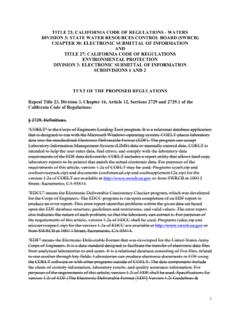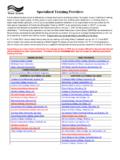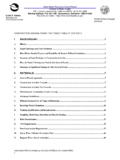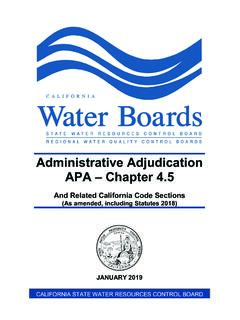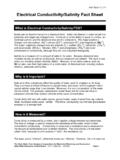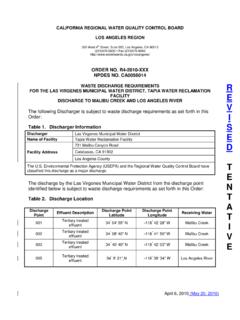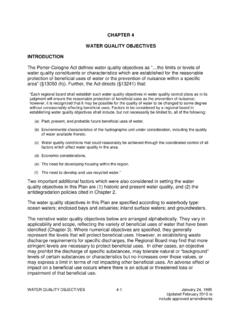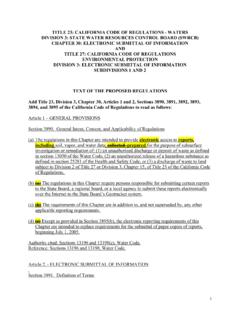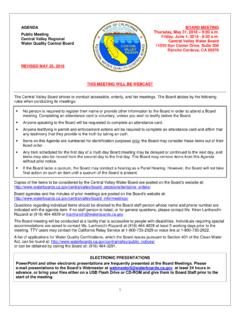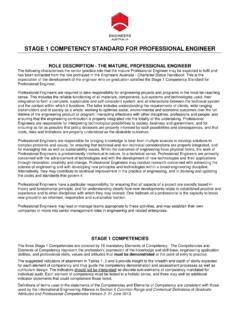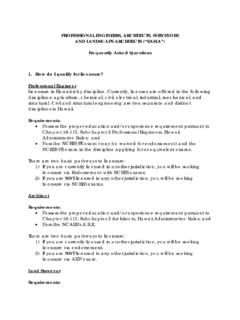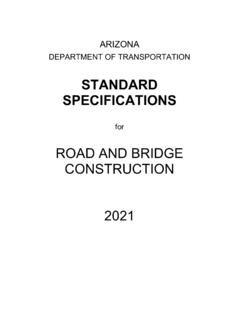Transcription of Jar Testing Made Easy - California
1 Jar Testing Made Easy Achieve meaningful, useful, and transferable jar Testing results by applying best practices learned from a recent study of 37 water treatment facilities in California . BY GUY SCHOTT, Guy Schott is a civil engineer with the California State Water Resources Control Board, Division of Drinking Water ( tml), Santa Rosa, Calif. Jar Testing and filterability procedures yield useful data to help water treatment plant operators and engineers select the best coagulant and optimum dose. As part of a California State Water Resources Control Board research project, more than 1,400.
2 Individual jar tests were conducted from 2018 to 2020 for 37 of the state's public surface water treatment plants using various treatment technologies. Field and laboratory results validated the developed jar test and filterability procedures, accurately predicting full- scale plant filtration performance and indirect organic reductions. JAR Testing CONCERNS. Water treatment plant operators add coagulant(s) to neutralize negatively charged particles and combine them into larger particles for removal. Jar Testing can be used as a tool to help select the proper coagulant and dose for the reduction of pathogens and disinfection by-product pre-cursors.
3 However, existing jar Testing procedures can be involved, time consuming and may not provide the necessary data to make informed decisions on the selected coagulant type and dose for transferable full-scale plant performances. Treatment plants with flocculation and settling basins are designed to remove as much suspended solids and dissolved organic carbon (DOC) as practical before filtration. To achieve this goal, selected coagulant(s), doses, mixing energies and flow contact times 1. are adjusted to produce a settleable floc. plants with pre-roughing filters (nonbuoyant and buoyant medias), are designed (media type, size, depth and contact times) to generate a removable floc through hydraulically produced energy.
4 Any pre-treatment carry-over floc should be robust so it can be removed in the final media filtration process . The same principals are valid for membrane treatment plants with pre- treatment, as reducing suspended solids and dissolved organics are critical parameters in reducing membrane fouling and disinfectant by-products. It's important to optimize settleability of formed flocs for solids reduction, longer filter runs, and improved overall treatment plant performance. Just as important is the need to optimize the reduction of DOC and media filterability of carryover floc particles that aren't settled or physically removed in the pre-treatment process stage.
5 By working with several water treatment utilities, it was determined that filterability analysis on carry-over floc and indirect measurements of DOC removal generally aren't performed. Utility personnel that do perform filterability Testing may use a method and/or analysis that does not generate transferable data to full-scale plant filtration performance. The California State Water Resources Control Board's research resulted in a filterability technique and indirect dissolved organic measurements will be discussed that provides good transferable data to full-scale plant performances.
6 JAR TEST FIELD STUDY. The 37 surface water treatment plant sources involved in the research were jar tested to develop, improve and validate jar Testing and filterability procedures. Many of these plants were visited multiple times during different seasons. The practical procedures developed and described here generated good floc production that allowed the evaluation and analysis of selected coagulants, dose, filterability, indirect dissolved organic reduction and settleability. The jar test results are representative of full-scale plant performances which was confirmed by comparing coagulant dose, filtrate turbidity and indirect organic reduction.
7 Measurements. Measured jar Testing parameters were filtrate turbidities, filtrate %UVT/UVA and settled water turbidities. Source water turbidities and UVT/UVA were also measured. Ultraviolet transmittance (UVT) is a measurement of the amount of ultraviolet light (254 nm wavelength) that passes through a water sample compared to the amount of light that passes through an organic free water sample expressed as a percentage, %UVT. UV absorbance (UVA) is a relative measure of the amount of light absorbed by a water sample compared with the amount of light absorbed by an organic free water sample.
8 These parameters are an indirect measurement of dissolved organic carbon. If one parameter is measured, the other can be calculated (UVA = - log(%UVT/100); %UVT = 10(-UVA) x 100%). UVA values have a linear relationship of organic matter in water. For example, if the concentration of organic material in the water were to reduce by half via treatment, then UVA would reduce by half. UVT values do not have a linear relationship to organic concentration. Humic substances absorb UV light at 254 nm, whereas nonhumic substance are low in UV absorption at 254 nm. Humic substances comprise about 60-80% of soil organic 2.
9 Matter and are removed through the coagulation/filtration process . Nonhumic substances comprise about 5-25% of the humus in soils which are nonamenable to enhanced coagulation. Two source waters with the same UV absorbance value can have very different percent organic properties. Jar Tester. A four-jar tester using 1-Liter round beakers were used for nearly all field and laboratory studies. Most source waters were collected at the plant and transported back for laboratory jar Testing . The benefits in using 1-liter round jars over 2-liter squared jars are (1) 50 percent less water required for a set of jar Testing , (2).
10 Mathematically easier for preparing stock solutions, (3) ease of drawing samples for analysis, and (4) easy cleaning and storage. Flash Mixing. Flash mixing at 200 revolutions per minute (RPM) for 30-60 seconds using 1-liter jars to rapidly disburse the coagulant(s) was used for most studied sources. To evaluate the impact flash mixing had on filtrate turbidity, %UVT/UVA and settleability, mixing duration was varied from 60-0 seconds for selected sources (Table 1). In most cases, jar Testing with and without flash mixing had no significant impact on filtrate turbidity and %UVT/UVA.
